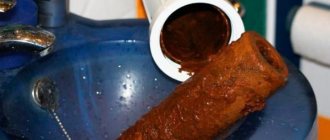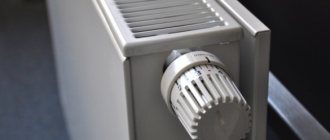Probably everyone is familiar with this situation when you open a tap with hot water, and barely warm liquid runs out of it.
It’s not every time that you have the opportunity to wait for a lucky moment until water at the desired temperature comes out of the tap, and the presence of a meter that takes into account every resource consumed has developed a strong habit of saving.
So it turns out that most often in the morning we wash ourselves with cold or barely warm water, not to mention the fact that those who like to take a shower in the morning have a very difficult time. But what to do if cold water flows from a hot tap with enviable regularity, where to complain and how to solve the current problem?
Why is this happening?
This problem may have the following reasons:
- heat exchanger contamination;
- heat exchanger failure;
- corrosion inside the pipeline;
- the appearance of rust inside the risers.
The reason may also lie in the shutdown of the heat exchanger in the house. This usually occurs in cases of equipment repair or in case of an accident in external pipeline sections.
Appeal to the Criminal Code
If neither you nor your neighbors have any problems, but the water supply is still incorrect, you will need to contact representatives of the management company by phone. Employees will accept the complaint and then organize a procedure to resolve the problems.
The complaint will need to include the following information:
- information about the addressee: position, full name;
- information about the applicant: full name, residential address, contact information ( telephone number, e-mail );
- the name of the complaint is about the non-compliance of the domestic hot water supply with regulatory indicators;
- an indication of what sanitary norms and rules the hot water supply must comply with, that the hot water supply must be uninterrupted and around the clock all year round;
- description of the current circumstances: when the problem with water arose, what it was ( for example, to gain access to hot water, you need to drain the cold water for a long time );
- an indication of the ways in which the applicant tried to solve the problem (for example, a locksmith came, but the problem was not solved );
- an indication that the applicant fulfills his obligations to pay for services on time and that he has no debts;
- please measure the temperature of the hot water supply, draw up a report, fix the problems within the specified time frame, and recalculate the water fee;
- please send a response to the specified contacts;
- date of application, full name and signature of the applicant.
You can cooperate with other residents and make a collective complaint. The document must contain at least 50% of the residents of the entrance.
When the Criminal Code refuses to accept the complaint, you can submit it by registered mail with a list of attachments and acknowledgment of delivery. If management staff are in no hurry to fix the problem, you will need to perform the following actions:
- send a complaint to the housing inspectorate regarding the unorganized work of management company employees;
- send a complaint to the territorial department of the prosecutor's office;
- file a complaint with local administrative authorities, asking them to look into what happened;
- organize a meeting for the residents of the house to discuss the problem: if all those present agree, then you can terminate the contract with the current management company and renew it with a new organization.
If the actions are unsuccessful, you need to go to court. The claim will need to indicate all documents and evidence of the fact that the management company’s employees are ignoring their official obligations. It is recommended to consult with a lawyer - he will tell you the procedure and the list of necessary documents.
Difference in causes for open and closed water supply systems
Both of these systems are different. In open cold water, in order to heat up, it must come into contact with the coolant itself. In a closed system, water is heated by heat exchange.
The difference in the reasons why cold water flows from a faucet instead of hot water is as follows:
- high accident rate of open systems compared to closed ones due to their location (in the event of an accident on the pipeline, the water supply is completely stopped in the entire water supply system);
- low accident rate of closed systems (in the event of an accident, water continues to flow into apartments, going around the damaged section of the pipeline);
- rapid cooling of hot water in open systems due to its unstable distribution;
- stable maintenance of hot water temperature in closed systems, due to which they are less likely to fail.
Open systems often have low pressure, which means hot water does not reach consumers living on the upper floors. This requires the installation of booster pumps. In closed ones there is a large loss of water. They often need inflating pumps.
In such systems, heat exchangers often break down, due to which not hot, but cold water flows into apartment taps.
The water is too hot
If the water is too hot, the most likely reason is that the tank thermostat is set too high or is faulty. When the temperature is set too high, the solution is simple - adjust it properly. This is done with a screwdriver.
Before adjusting the immersion heater thermostat, turn off the power supply as you will have to remove the unit's cover.
If the thermostat of the heating system storage tank is located on the side, then there is no need to turn off the power supply.
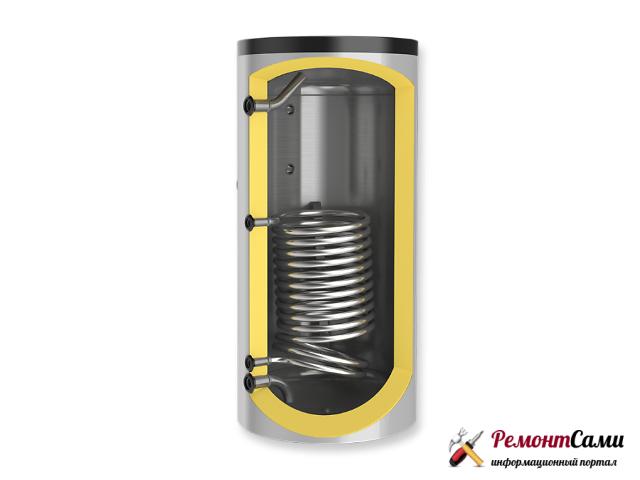
In both cases, set the water temperature to 60 °C at the top of the tank. However, if the thermostat is faulty and simply does not work or turn off the heat, then it will probably need to be replaced. This is a relatively simple operation to make electrical connections to the terminals of the new device, but you must turn off the power supply before proceeding. This is discussed later in the article.
On a note
The ideal temperature of water stored in the storage tank of a home hot water system for distribution to taps is 60 °C. Storing water that is too hot creates a risk of scalding; In areas with hard water, there is an additional problem of limescale deposits. Storing water at too low a temperature can lead to the development of Legionella bacteria, which causes legionellosis.
How to find out the reason in a particular case?

To find out the exact cause, you need to check the pipes in the basement of the house.
It is necessary to look at the condition of the pipeline section that approaches the riser. To do this, you need to invite a specialist from the management company to inspect the pipes in the basement of the house.
It is important to check the condition of the risers themselves. You should invite a specialist from the management company to check the risers for the presence of rust inside them.
In any case, you will need to check the operation of the heat exchanger in the house. It is this device that often causes interruptions in hot water supply in homes. Only a representative of the management company, who should be invited to the house upon a pre-submitted application, can check the heat exchanger for blockages and damage.
If the above options do not reveal the cause, then you should contact the water utility and generating companies servicing the house. They are responsible for the condition of the external pipeline.
After filing an application, they are required to send a representative to check the condition of external pipeline sections throughout the area of the possible accident.
Measuring device with temperature sensor
Despite the attractiveness of this method, there are several nuances. Firstly, the recalculation of the cost of any utility services must be carried out with the participation of employees of the management organization, drawing up an act, etc. Secondly, the installation of such a measuring device is impossible without the participation of the same representatives of the management organization.
- Instead of hot water there is warm water, why complain?
- Cold water from a hot tap where to complain
- Cold water from a hot tap where to go
- Government Decree No. 354 of May 2011, which contains all the criteria and requirements for the quality of public services.
- Sanitary standards for hot water supply in residential buildings dated April 2009 No. 20.
Instructions for solving the problem
To cope with this problem, you need to follow an algorithm. It is important to know where to go and how to file and send a complaint. A separate point is the possible result of such treatment.
Where to contact?
In such situations, the first instance is the management company. She is responsible for ongoing maintenance work on the pipeline inside the house.
If the reason why cold water comes out of the tap instead of hot water in houses is due to damage to the pipeline in the area outside the houses, then you should contact the city water utility.
In case of accidents at pumping stations, it is recommended to contact the generating company that services the home to resolve the problem with hot water.
How to write an application?
The application is made in a free format. It should indicate the following points:

the name of the management company, water utility or generating company to which the complaint will be sent;- address of these organizations, their head;
- Full name of the applicant and his address;
- the very name “complaint” is in the middle of the line;
- a detailed description of the situation when it was revealed that cold water flows from the tap instead of hot;
- a specific request to the organization to resolve the situation;
- date of writing the document;
- signature of the person applying.
If necessary, you can attach documentation to the complaint that will confirm the fact of improper supply of hot water to the house.
How to file a complaint?
A claim regarding this case must be submitted only in writing. Management companies will not respond to verbal complaints from consumers. The application is sent to the management company in two copies.
A mark is placed on one of them that it has been accepted for consideration. Similarly, the complaint is forwarded to the water utility and the generating company.
Result of the request
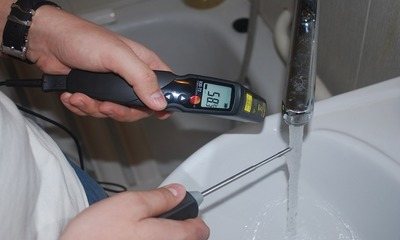
It measures the water temperature at water intake points. Two such measurements are made.
The first is in the morning, the second is in the evening. Based on the results of the measurements taken, the management company’s employee draws up a report.
It confirms the fact that there is a disruption in the supply of hot water to the apartments. The document is made in two copies. One of them remains with the consumer.
The management company is obliged to make a recalculation based on the act of measuring the temperature at water collection points . For the next period, the consumer who submitted the application should have their DHW fees reduced.
Or he will pay for it at the same rate as for cold water, if the measurement shows the temperature of the hot water below the 40-degree mark.
If the reason lies in contamination of the heat exchanger, then the management company employee cleans it. If the problem is a device failure, the management company replaces it. It is also possible to replace only individual elements of the heat exchanger.
If the pipes become clogged, the management company worker cleans them or completely replaces a separate section of the pipeline. Also, the solution to the problem may be limited to cleaning the screens on the mixers.
Where to file a complaint
To file a claim with a higher authority, you must have a document in hand. The first department you should contact is the management organization or housing and communal services. The company is obliged to recalculate the payment, and the period from which to start ends with the date when the violation is completely eliminated.
If the culprit refuses to satisfy the residents’ complaint, they have the right to submit a similar demand to the territorial body of the state housing inspection. Its employees must respond to the application no later than 30 days from the date of its submission. If the claim is satisfied, according to the law, 45 days are allotted for the complete elimination of all violations. If there is no result, the only solution is to file a lawsuit.
If the water does not meet quality standards, smells bad, has an unpleasant taste, the algorithm of consumer actions is the same. For non-compliance with quality characteristics, recalculation must also be made. If the claim is satisfied during the proceedings, all costs will fall on the management company. In addition, they will be required to recount as soon as possible.
What to do if the problem is not resolved?
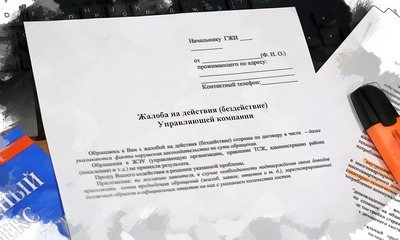
She acts as a supervisory authority and monitors the work of the management company.
You should also complain to the housing inspectorate about the inaction of the water utility or the failure of the organization to fulfill its duties.
It controls all organizations involved in the housing and communal services sector.
An alternative option may be to contact the local administration. A written complaint can be submitted through the reception desk. You can also send it via mail.
It is allowed to complain about management companies, water utilities and generating companies to Rospotrebnadzor and the prosecutor's office. Their function is to supervise how housing and communal services organizations carry out their work.
If these authorities do not assist in solving the problem, then you should go to court. It is necessary to file a claim. It can be sent by mail or transmitted through the court office. A number of courts allow filing claims in electronic format.
Radiators don't heat up
If the radiators do not heat up, this may be the result of a fault in the power supply, as stated above. However, if power is supplied to the boiler and the pump, then the problem may be in the pump itself.
You can check whether the pump impeller is rotating by placing the end of a large screwdriver against it and placing your ear on the handle. The sound will travel through the tip and handle of the screwdriver, and you will hear whether the impeller is rotating.
You can check whether the impeller is spinning by unscrewing the large center screw from the pump housing, which will allow some water to flow out. Behind this large screw you will see another, smaller screw that will rotate if the pump is running.
If not, try turning it with a screwdriver; if you are lucky it will start to spin and pop out from under the screwdriver as it spins fast.
In this case, replace the large screw to stop water leakage. I will take the liberty of saying that a sharp, gentle blow with a hammer on the side of the pump sometimes resumes its operation. If the impeller does not want to rotate, then the pump needs to be changed.
Replacing the heating system pump
Having determined that the pump is faulty, you will need to buy a replacement of a similar design. Then the problem is solved as follows:
1. De-energize the boiler and pump by turning off the machine and removing the fuse. Once you are sure there is no power, remove the old wires from where they enter the pump.
2. If you're lucky, there will be a shut-off valve on each side of the pump. They are overlapped by turning the two slotted heads with a screwdriver (or wrench) a quarter turn. If there are no shut-off valves or they do not work properly, the entire system will have to be drained (see article).
3. With the water turned off, you can now unscrew the large nuts on each side of the pump and remove it.
4. After removing the old pump, install new gaskets, if used in this design, and apply a little sealing compound to the joints when installing the new pump.
5. Tighten the connections securely, securing the new pump in place.
6. Now turn the water supply back on and check for leaks.
7. If everything is in order, you can turn on the power and check the system.
After installing a new pump, you need to set the pump speed, if it is adjustable, to the lowest value and increase it only if all the radiators do not heat up. Too high a speed may result in unacceptable sounds within the system.
If there is any doubt regarding the wiring of the circulation pump, contact a qualified electrician.
On a note
If there is any doubt regarding the wiring of the circulation pump, contact a qualified electrician.
Otherwise, you expose yourself and others to the risk of electric shock.
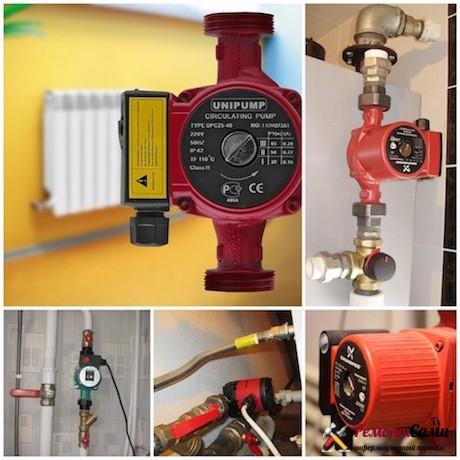
Prevention
One of the options to prevent such a situation is to regularly monitor the condition of the heat exchanger in the house. It is recommended to check the condition of the device monthly for blockages and corrosion.
For prevention, the condition of the pipeline in the basements of houses should be checked monthly. Particular attention should be paid to those areas that are connected to risers.
At the first signs of corrosion, the pipes must be cleaned immediately . The same goes for the risers themselves. Their condition must be monitored by designated employees of the management company. At the first sign of clogging, the riser needs to be thoroughly cleaned.
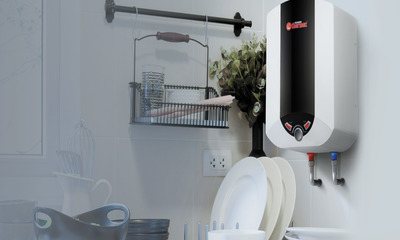
A way to solve the problem could be to install a separate water heater in the apartment.
This is especially true for old houses, in which the pipeline system often fails.
If there are frequent interruptions in the supply of hot water, a water heater will be able to smooth out the problem .
The resident will always have a certain supply of hot water if necessary. But this will inevitably lead to an increase in utility bills for electricity.
One option is also to install water meters with a temperature sensor in the apartment. This device will not solve the problem with the supply of hot water, but will help reduce payments for water if it is supplied to the apartment at insufficient temperature.
A water meter with a temperature sensor will help the consumer monitor the quality of hot water in his apartment.
The boundary of common property in an apartment building - what is it?
What can be the boundary of common property in an apartment building? The limit of liability can be determined in accordance with the agreement between the management company and the resource supplying organization. This could be the outer wall of the house. If a heat meter is used, the connection point between the device and the utility network.
Thus: if the resource supplying organization provides hot water supply that does not meet the standards, then the management company can challenge the invoices for payment of thermal energy.
